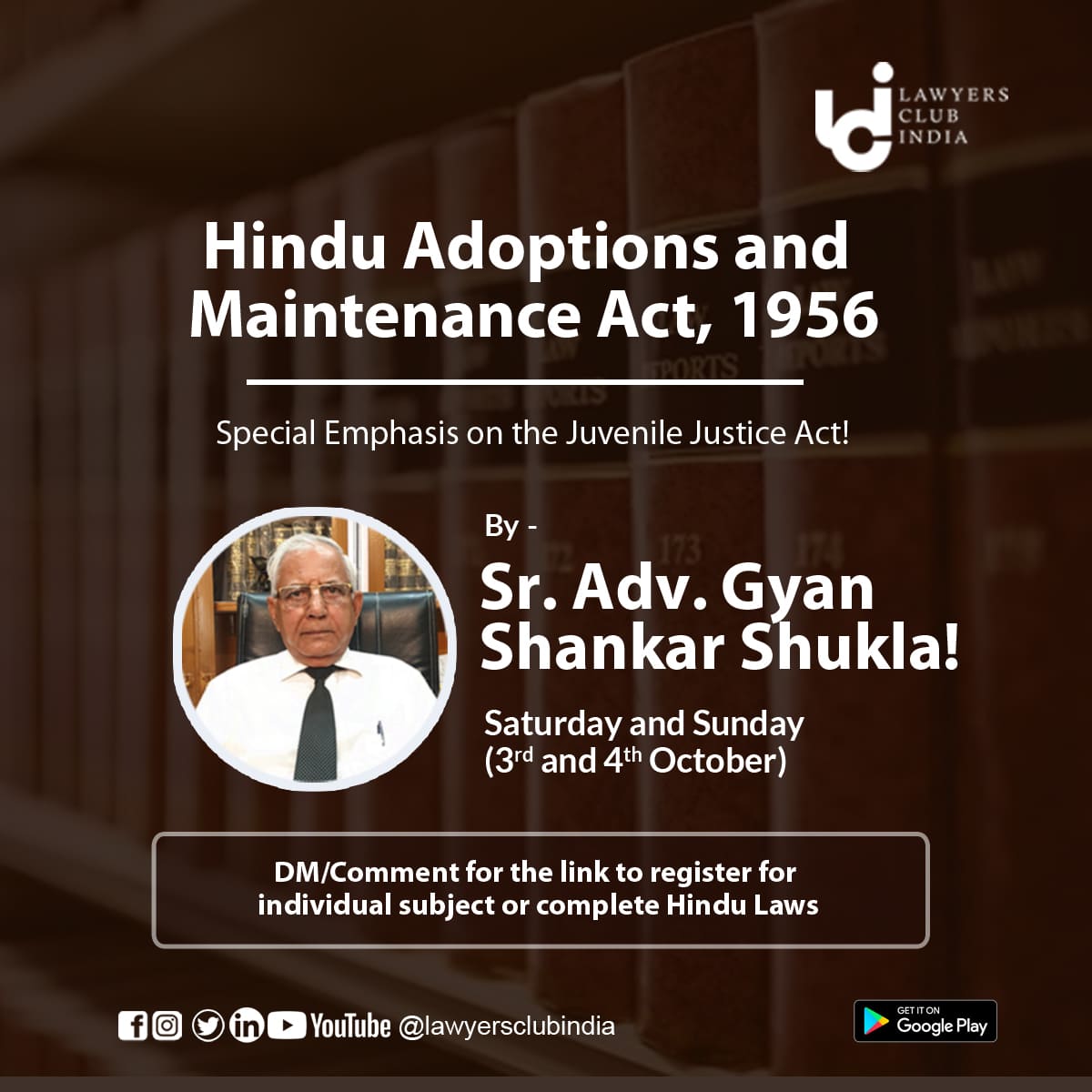Bench:
S Dani
Issue:
Can Nemichand be held as the adopted son of Kundanbai?
Facts:
• Shantilal Patni was the husband of Kundanbai and father of the defendant Basantabai. Shantilal expired in March 1969, leaving behind wife and daughter but no male issue.Deceased Shantilal had agricultural land which came to be acquired by the Government and the compensation amount was lying in the office of the Land Acquisition Officer, Aurangabad at that time.

Enroll the Complete MasterClass Course on Hindu Laws: Click Here
• Shantilal had not left any male issue behind so his wife adopted Nemichand as her son in April 1969. Nemichand when adopted was married and 30 years old.
• According to Nemichand he was adopted as per the desire of Shantilal and all the customs and ceremonies were duly performed. According to him he was the successor of Shantilal’s property as adopted son.
• Kundanbai died in January 1973, before that she had executed an adoption deed in November 1970.
• The plaintiff therefore claims to be the an adoptive son of the deceased Kundanbai and has challenged her last will executed in favour of the defendant.
• To get a declaration as adopted son and for the relief of perpetual injunction restraining the defendant from receiving the compensation amount of the property, the plaintiff Nemichahd filed Regular Civil Suit.
• The suit was resisted by the defendant by a written statement and the adoption as well as the deed came to be denied. The defendant, being the daughter of Shantilal claimed ownership by succession. It was further stated that, after the death of Shantilal, she and her mother Kundanbai succeeded to the property and deceased Kundanbai herself in her lifetime executed her last will in December 1972 bequeathing her interest in the property in favour of her daughter-defendant.
• On framing necessary issues and on consideration of evidence on record the trial court refused to accept the plaintiff as adopted son of the deceased Kundanbai and further held the defendant as entitled to the property on the basis of will deed. The plaintiff was declared non-suited and his second regular appeal was also dismissed by the Court.
• Against these two decreed the plaintiff approached the Bombay High Court in the current second appeal.
Appellant's Arguments:
• Parties to this litigation are Jains and the object of adoption in this community is to secure an heir and perpetuate the adopter’s name.
• The adoption has no religious significance and there is no restriction of age or marriage nor any special ceremony is necessary to give legal effect to adoption. The custom to adopt a married boy without any restriction of age was neither immoral nor against the public policy.
• Hindus in Marathwada area were governed by Vyavahara Mayukha School of Hindu Law. The present parties of present proceedings are Jains and from Marathwada area, the custom there being recognized by law, makes the adoption of the plaintiff legal.
Respondent's Arguments:
• There are additional hurdles in the way of the plaintiff and the adoption has to be held invalid because of non-compliance of conditions (iv) and(v) of Section11 of the HAMA, 1956. These two conditions do not accept any exceptions and there can be no question of any custom or usage in the community providing otherwise than required by these two conditions.
• For a valid adoption the adoptive mother should be at least 21 years older than the person to be adopted and further the child must be shown to have been actually given and taken in adoption.
Judgment:
The Bombay High Court held that both the Courts below had rightly held that the plaintiff cannot be held adopted son of Kundanbai and he has been rightly denied his succession to the properties of Kundanbai. The suit of the plaintiff for declaration as an adopted son of Kundanbai has therefore been rightly dismissed. Admittedly, the defendant-respondent is the daughter of Kundanbai and Kundanbai has also executed her last will in her favour bequeathing her own share in the suit properties in favour of her daughter after the death of her husband Shantilal. The plaintiff was, therefore, rightly non-suited in respect of the consequential relief of perpetual injunction restraining the defendant from receiving the compensation amount which was due and payable to her. The Second Appeal was dismissed and there was no order as to costs.
Relevant Paragraph:
11. As stated above, the plaintiff was admittedly 30'years old at the time of the adoption. It is further admitted by the plaintiff in para 16 of his evidence so also the adoption deed (Exh. 116) that Kundanbai, the adoptive mother, was 50 years old at the time of the deed (Exh. 116). Admittedly, the adoption ceremony was performed on 11-5-1969 and the deed (Exh. 116) is dated 21-11-1970. It is, therefore, clear that at the time of the adoption, the plaintiff was 30 years old while the adoptive mother was 48 years and 6 months in age. As such, the adoptive mother Kundanbai was older by 19 years than the plaintiff. There is, therefore, the breach of condition (iv) as the adoptive mother was not at least 21 years older than the person adopted. There is also a legal bar against the valid adoption of the plaintiff raised by condition (vi) of S. 11 of the Act. There is absolutely no evidence in the case at hand that the plaintiff Nemichand was actually given and taken in adoption by the parents or guardian concerned as required by that condition. It is in the evidence of the plaintiff himself as well as his three witnesses that the plaintiff Nemichand himself sat on the lap of Kundanbai and the adoption was effected. There is no whisper in the evidence that either the parents or the guardian of Nemichand actually gave him in adoption during their lifetime. It is laid down in the said case that, nature of the ceremony may vary depending upon the circumstances of each case but there must be a ceremony of giving and taking. As stated above, this condition No. (vi) of S. 11 of the Act does not accept any exception or explanation in the form of a contrary usage or custom prevalent in the community. The only proviso is in respect of performance of Datta Homa and it is, therefore, clear that there may not be the performance of Datta Homa but there must be actual giving and taking in adoption of the child that is essential to the validity of an adoption. As stated above, the evidence in the case at hand not only falls too Short but is totally absent on this count.
Therefore, the conditions (iv) and (vi) of S. 11 of the Act are not at all complied with and as such, the adoption of the plaintiff cannot be upheld as valid. It may also lastly be mentioned that the conduct on the part of the plaintiff subsequent to the alleged adoption is also eloquent and both the Courts have found that in respect of this alleged adoption, the plaintiff Nemichand continued his actions and dealt with the properties not as a son of Kundanbai but in his prior name as if there was no adoption at all.










